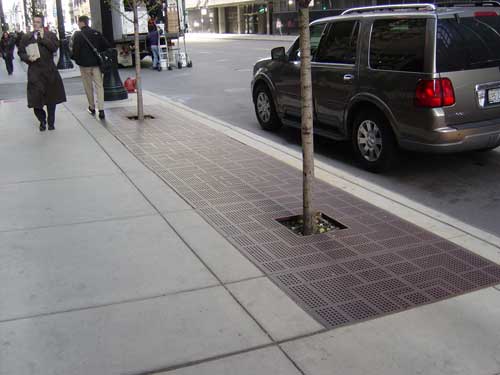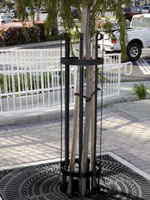Pedestrian Friendly: Planting Trees and Celebrating Stormwater in Urban Areas
Look Up and Down - Street Trees
Whether a southern palm tree or a northern maple, trees provide shade and a leafy canopy which filters the light, brings color and provides a home for birds in urban spaces. Trees reduce the urban heat island effect and can be part of an urban stormwater detention system. They can be planted in raised beds or along a confined setback area. In downtowns, they are often planted below tree grates which are integrated into the sidewalk system. The components of a successful sidewalk planting system include:
- Proper spacing
- Proper planting depth and protection from soil compaction
- Sufficient root growth area to support mature trees
- Flexibility to provide for increased tree growth
- Durability, materials and maintenance
- Safety and ADA compliance
Proper Spacing
Filtered light is created by spacing trees along the sidewalk.   The pilot program for neighborhood planning is LEED ND® Neighborhood Pattern and Development (NPD). NPD Credit 7: Walkable Streets, recommends that designers space trees at intervals of no greater than 40 feet apart.ii This section also recommends that within five years, half the sidewalk should be shaded as determined by the width of the shade when the sun is directly above the tree. A downtown sidewalk between 12 and 20 feet wide can provide space for walking, dining and street trees.  "Fifteen feet is usually the minimum width for an active retail street with outdoor cafes and street trees. However, I have seen good streets as narrow as ten feet, usually with on-street parking to help buffer pedestrians from traffic, "said Cory Gallo, urban designer at JJR in Ann Arbor, Michigan.
Spaced to provide shading for pedestrians, trees also reduce the heat island effect, the elevated temperatures in urban environments that can impact the demand for energy, air-conditioning and also increase air pollution.iii The health benefits of trees are well documented. Trees provide a filter for pollution breathing in carbon dioxide and returning it as breathable air. "When trees and vegetation reduce energy use, they also reduce CO2 emissions from power plants.  In addition, vegetation removes atmospheric CO2 by sequestration. Trees sequester − or store − between 35 and 800 pounds annually depending on their size and growth rate."iv There is up to a 60% reduction in street level particulates with street trees.v Other pollutants such as sulfur dioxide, ozone and nitrogen oxides are also absorbed by trees.vi
Trees also reduce noise and the acoustics of a noisy street is modified through tree plantings. Trees in urban areas may even reduce crime and domestic violence. Trees need sun, water and the nutrients from the soil to mature. Paved, downtown streetscapes need to be well designed to nurture trees so that they will in turn, nurture urban pedestrians.
Growing Pains
Tree grates are one means to integrate trees into the streetscape. Properly installed, tree grates protect trees from pedestrians and pedestrians from trees. Tree grates eliminate compaction of the soil at the base of the tree due to constant foot traffic that can inhibit or damage root growth. Tree grates also protect pedestrians from trip hazards due to the hole produced by an open tree well. Tree grates also allow for irrigation of trees if required while providing a pedestrian "bridge" over muddy or flooded planters.
Most cities require that street trees should be at least 2 inches caliper in trunk diameter. Many cities provide a list of recommended trees to plant by in their particular climate zone in downtown areas. For example, the city of Portland, Oregon provides numerous planting guidelines in their city codevii and specific trees are listed as recommended for use in the Portland urban forest. Many urban foresters recommend having a wide range of tree genus in any given location to provide biodiversity. This guards against a catastrophic loss of trees should one species fail due to drought, insect infestation or some other natural stress not present at the time of the initial planting. Most cities will also require that trees and other plant materials must be maintained and replaced as necessary and proper planting and irrigation techniques will reduce replacement costs. Â
Tree planting areas should be sized for the tree at maturity, for example, the roots of a palm tree might require a different space than a Gingko tree. The designer should know the tree type and growth patterns for the regional climate when specifying trees. Manufacturers provide grates for a variety of standard tree planter sizes or they can provide custom sizes as specified.Â
A four foot by four foot tree grate may fit into the sidewalk spacing, but a four foot by four foot planting hole may not be large enough to sustain proper tree growth. Roots are the collectors of water and nutrients for a tree as well as its anchor, so a healthy root structure is critical to a healthy tree. Typically a tree needs as many cubic feet of soil for roots as the area in square feet under its crown or leaf spread. Roots are usually limited to 3 feet below grade so a tree expected to have a 24 foot wide canopy would need 148 square feet of planting area at grade for optimal root growth. The compacted soils beneath most sidewalks and roadways are poor areas for roots as they lack oxygen and moisture necessary for root growth and tree metabolism. Therefore, it is best to provide as much planting area with nutrient rich and properly draining soil as possible. Using large tree grates and / or incorporating structural soils are options. A four by twelve foot tree grate or a longer grate which can incorporate several trees as shown in this Chicago streetscape are two options to provide for the mature growth of the street trees. In this way tree grates can be used to "buy" some pedestrian space while optimizing tree growing space. Trees can also be planted in raised planter beds where space is available.
 |
Windy, wet, dark and cold downtown Chicago is a harsh place for a tree.?The designers of the Hyatt Project solved many growing pains by creating a long planting bed using this structural steel and cast iron tree grate system. Photo courtesy of IRONSMITH |
Â
In addition to planting space, tree grates should also allow for proper trunk growth. Grates should be selected with openings adequate for the tree trunk at maturity. Many grates will have "knock out" panels that can be removed through the use of a portable grinder with an abrasive wheel. After scoring, a sharp tap with a hammer will remove the excess material to enlarge the grate for future growth. An expandable grate will provide a series of concentric rings designed for strength and to maintain the aesthetics of the tree grate even as it is expanded.   Grates that are expandable will list the expansion size to which the grate can be adjusted.
Case Study: Planting Trees in Downtown Chicago |
When the Hyatt Center was constructed, the designers had to work within a complex streetscape. Coordinating architectural firm A. Epstein was also the architect of record, working in conjunction with design architect Pei Cobb Freed and Partners, LLP, New York. The Hyatt Center is a 1,800,000 square foot, 48-story office building on a one-half block site bounded by Wacker Drive, Monroe Street, Franklin Street and Arcade Place in Chicago, Illinois. The project incorporates approximately 300,000 square feet of office space for the Pritzker Companies, including Hyatt Hotel's corporate headquarters; 475,000 square feet for the law firm of Mayer, Brown, Rowe and Maw; 270,000 square feet for commercial banking firm Goldman Sachs; and 430,000 square feet of speculative office space. Two below-grade levels provide parking and one mezzanine level contains food service and a health club facility for the building tenants. The civil engineering and site work for this project was more involved than most typical downtown developments due to the project location, adjacent to Wacker Drive, a bi-level roadway system. Normal details such as the sidewalk, curbing, driveways, utility service connections and landscape coordination issues normally associated with a downtown development at one level, needed to be addressed at two different street levels. The sidewalks along Monroe and Franklin, the west boundary of the site, are vaulted sidewalks. |
Â
 |
Tree guards can be added to a tree grate to protect trees from pedestrians. Photo courtesy of IRONSMITH |
A new type of grate system supports pavers above the tree well. This system was used in the Tempe Transportation Center case study and allows for more pedestrian walk areas with a smaller open grate surface.  This system:
- Greatly reduces the area for weeds and trash accumulation
- Cuts down on tree area maintenance
- Allows easy fertilization and irrigation
- Keeps roots from lifting pavers
- Seamlessly incorporates any size tree pit, utility corridor, etc.
Some grates include protective tree guards attached to the tree grate.  A tree guard is a means to support the young tree while it is being established on the sidewalk. It can prevent pedestrians, bikes, skateboards, or chairs, bumping into trees, trees becoming bicycle racks and sometimes even prevent dogs from watering the trees. Tree guards are fabricated in halves and drilled and then bolted to the tree grate. They can also be mounted on a cross bar as an option with the grate frames. The standard height is 5' and the standard tree opening is 16", however, any height and opening may be specified.









